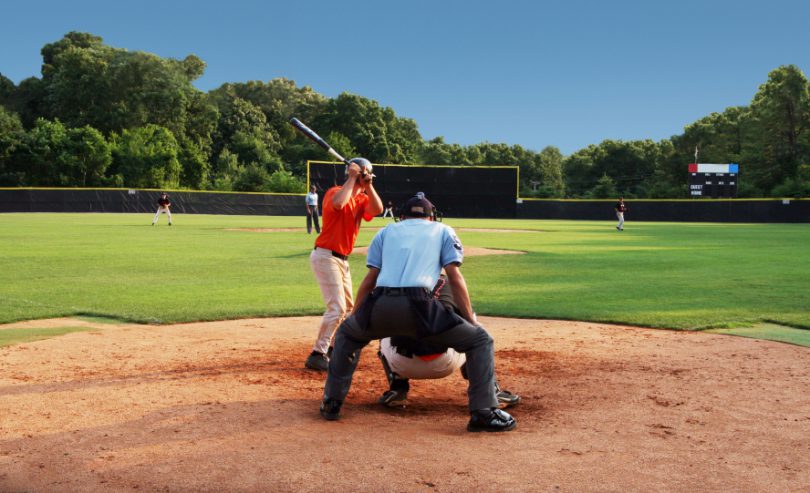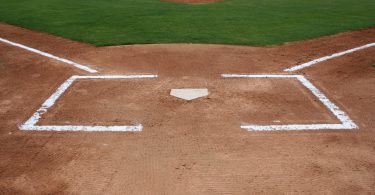By Ethan Guevin
Last time, we started a series to improve your base running. We shared some “universals” that apply to running the bases no matter where you are on the base paths. Now it’s time to start talking about specific ways to improve your base running based on your starting point. Obviously, the place to start is right out of the box.
Once the ball is put in play, your first job is to start running. As you take your first few steps in a straight line to 1st, peek at the ball and analyze the situation. In doing this, you should be able to determine what type of route you need to take to 1st base. Depending on where you hit the ball, you may have to peek farther down the line and adjust from there. No matter what base you are trying to get to, you want to be running as short a distance as possible (90’ ) to your last base. After peeking and reading the ball, you will do one of the following:
1. Run hard straight through 1st base
Type of hit: Ground ball that stays on the infield or shallow outfield where there is a possible play at 1st base. Since 1st base is the base you are trying to reach, you should run in a straight line (90’) from home to 1st
– Run hard all the way through the base.
– Step on the front 3rd of first base with whichever foot gets you to the base without breaking stride.
– DO NOT lunge/jump to reach the base (this will slow you down).
– After running through the base completely, drop your hips, chop your steps and look over your right shoulder for an overthrow that would allow you to get to 2nd base.
– Dive head first only to avoid a tag by the person covering 1B (talk to your coach about his rules about diving head first – he may not allow it).
2. Round 1B aggressively anticipating that you will go to 2nd on a bobble by the OF or a ball that will allow you to get to 2nd
Type of hit: Sure single to the outfield with no possible play at 1st, or a possible double
– Start getting wide as soon as you know the ball will get to the outfield and there will be no play at 1st. Getting wide early will allow you to hit 1B running full speed. Use a banana curve rather than the question mark route. The “?” route to first forces you to try to make quick direction changes at full speed. It is not possible to make big direction changes like this without slowing down.
– Hit the inside corner of 1B and drop your left shoulder, allowing yourself to drive towards 2nd in as straight a line as possible.
– The best way to take extra bases is to find the appropriate width around 1st to allow you to round in a straight line towards 2nd without losing speed. Remember, you want to round first in as straight a line towards 2nd as possible.
– Don’t take your eye off the ball. Round the base aggressively, anticipating a bobble that may allow you to move up. Think “Go, go, go!” until the fielder or the location of the ball makes you stop.
– On a possible double that could be contested by a throw, you should follow the same route. You want to be able to get to 2nd as fast as possible, which may mean that you have to be a bit slower to 1st in order to take the appropriate route.
3. Round 1B and go to 2nd
Type of Hit: Sure stand-up double
– On a sure stand-up double, knowing there is no possibility of a play to 2nd, you will take a route to try to get the extra base (3rd). You will try to round 2nd so that you are running as close to 90’ to 3rd base as possible without losing speed.
– You will be slower getting to 2nd than you would on a contested double, but your concern is getting to 3rd base as quickly as possible.
– Hit the inside corner of 1st base and drop your left shoulder, allowing yourself to drive towards 2nd . Instead of trying to keep the distance short from 1st to 2nd, stay wide, creating the appropriate route so that you will approach 2nd base the same way you would approach 1st in #2 above.
– Hit the inside corner of 2nd base and drop your left shoulder, allowing yourself to drive towards 3rd in as straight a line as possible.
You probably have already figured out the route you would take on a sure triple, so we will leave you to your practice. When in doubt, follow the simple rule that you want to take a route that will allow you to run the shortest distance you can to your last base without having to slow down at any point along the way.
In the next article of our base running mini-series, we share base running tips for when you are already on base. Read that article HERE, or skip ahead to any of the other 3 articles of the series below:







